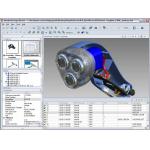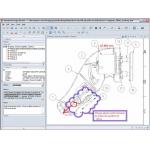Latest News
December 4, 2001
By David Cohn
Autodesk’s DWF format is fast becoming a widely accepted way to share CAD data in a secure, compact format. When first introduced, DWF contained only 2D data. Three years ago, the company updated DWF so that it could also support 3D, but 2D and 3D DWF files were entirely separate. Now, with the release of the 2007 versions of the company’s products, Autodesk has updated DWF so that a single file can contain both 2D and 3D data and a lot more.
In order to work with that data, the company has also updated its low-cost collaboration software with the release of Autodesk Design Review 2007. Formerly known as DWF Composer, Design Review adds a host of new capabilities.
Like DWF Composer before it, Autodesk Design Review enables users to view, measure, markup, and print DWF files previously published by users of any of the company’s other CAD programs—such as AutoCAD, Revit, and Inventor—and to subsequently republish those annotated DWF files. Users of Revit and AutoCAD-based products have long been able to open and view those annotated DWF files in the context of the original CAD application, but Inventor users had no similar capability. Autodesk has now remedied that situation with the concurrent release of Autodesk Inventor 11 DWF Extension, an updated version of Inventor available only to subscription customers. The new version of Inventor also enables users to include bills of materials and animated assembly instructions inside DWF files and to disable print and measure capabilities in published DWF files, if desired.
In addition to changing its name, Autodesk revised the Design Review user interface to accommodate all the enhancements. There are additional rollup palettes in the Navigator pane, with scroll arrows at the top and bottom. There’s also a new rollup bar that lets you hide the entire pane. The main window—in which you view the actual 2D and 3D sheets, images, and animations—has been renamed the Canvas pane. Below this are new Data and Text panes for viewing BOM (bill of materials) data and assembly instructions, respectively.
A Host of New 3D Tools
The Contents palette in the Navigator pane now shows both 2D and 3D data within a single DWF file, as well as any images, BOMs, and animations saved within the file. When viewing 2D data, the program’s markup capabilities remain largely unchanged from the previous release. When viewing 3D data, however, a host of new tools become available.
|
|
| Autodesk Design Review 2007 |
› › Figure 1: Autodesk Design Review now displays both 2D and 3D content in the same DWF file, as well as BOM data, assembly instructions, and rich metadata, such as the physical properties of parts.
Design Review includes an Orbit command that allows free rotation of the model and a Turntable command that lets you constrain rotation about an axis. When viewing a 3D model, you can select one or more parts in an assembly and then use the new Move and Rotate tool to move or rotate those parts. Design Review displays an XYZ tripod to help control those movements. Parts remain where you place them until you restore them to their original position.
A new cross section tool lets you view a cross section by cutting through the model with various section planes. Once created, you can move and rotate the planes to dynamically reveal the interior of parts and assemblies. Each section plane you create is added to a new Cross Sections palette in the Navigator pane. You can then use controls in this palette to flip planes or deactivate them so that the model is no longer cut by a particular plane. You can also reorient the model so that it is viewed perpendicular to a plane, reset the plane to its original location, or delete a section plane. You can’t rename the planes, however; they are simply numbered in the order in which you create them.
Controls in the Views palette let you reorient the model to any standard orthographic or isometric view, and you can also now save user-defined views. After you arrange items in the Canvas pane, you can save that arrangement to the Views palette. Views include the view orientation and all the current layer visibility settings, moved and rotated parts, and cross section states. Each view is initially numbered, but unlike section planes, you can rename saved views.
If the DWF file includes animations, the animation sequences appear in the new Animation palette in the Navigator pane. The animation itself displays within the Canvas pane and can be controlled using tools on the new Format and Animation toolbar. These controls let you play animations in forward or reverse, loop the animation, enable or disable camera changes that were included in the animation, and hide or display explosion trails. If the animation includes assembly instructions, those instructions appear as text in the Text pane. You can pause the animation at any point, use any view manipulation function (such as zoom, pan, orbit, cross section, move, or rotate) to interact with the animation, and then save the view to the Views palette.
If the DWF file includes BOM data, you can view the bill of materials in the Data pane. When you select a part, the part becomes highlighted in the Canvas pane, the BOM, and the Model palette, regardless of where you select it.
|
|
| Autodesk Design Review 2007 |
‹ ‹ Figure 2: Autodesk Design Review makes the process of reviewing and adding feedback to designs easier with a variety of markup and measure tools. The software tracks the complete history of each annotation, including the author’s name, the date of the revision, and the revision status.
As was true in DWF Composer, you can measure 3D models, but those measurements disappear if you reorient the model, and you still can’t actually mark up 3D models. Instead, you must first capture the contents of the Canvas pane as a 2D image of the 3D model. But whereas DWF Composer saved the 2D image as a separate DWF file, Design Review now simply adds the captured image to the current DWF file. You can then use any of the standard markup tools to annotate that image.
More General Enhancements Too
While many of the new tools focus on 3D, there are a host of other general enhancements. A new Import command lets you bring DWG and DXF files into Design Review. When you import a drawing file, Design Review first publishes it as a DWF file and then opens it in Design Review. The resulting DWF file contains a 2D model space view and a separate sheet for each paper space layout in the original AutoCAD drawing file.
In the past, if you wanted to add raster images or the contents of other DWF files to the current DWF file, you had to first open that content in a second instance of DWF Composer and then drag and drop that content between Composer windows. Now, you can simply drag and drop from the desktop or Windows Explorer directly into Design Review. You can also view thumbnails of DWF files in Windows Explorer and use Windows Explorer to search for text within DWF files.
The previous version of the software also let users add any DWF file as a custom symbol or stamp, but you couldn’t reorient those symbols. Design Review now lets you freely rotate those symbols as well as any text, rectangles, and ellipses you have added. You can also rotate raster images, but only in 90 degree increments and only if they don’t yet contain any markups.
A new Batch Print wizard lets you print multiple DWF files in a batch operation. Users can control the print settings for each DWF file and each sheet within multi-sheet DWF files, and save those settings for later use. You can also now print DWF files directly from within Windows Explorer and view or print color drawings and models as black and white or grayscale. And you can now email DWF files directly from within Design Review.
As was true in the previous release, Design Review comes with a copy of Autodesk’s free DWF Writer utility that lets you create DWF files from any application. In addition to simply printing to a DWF file, DWF Writer can also capture 3D data directly from other CAD programs, such as CATIA, Pro/Engineer, SolidWorks, Solid Edge, and NX. Also included is Autodesk Inventor View, a free application for viewing and printing Autodesk Inventor part, assembly, and drawing files; and DWG TrueView 2007, the latest version of Autodesk’s free utility for viewing DWG and DXF files and publishing them as DWF files.
With all the changes, DWF now offers capabilities not found in many other lightweight collaboration formats. And Autodesk Design Review 2007 provides just the right mix of tools for members of all design teams who need to collaborate with users of any of Autodesk’s many CAD programs.
David Cohn is a computer consultant and technical writer based in Bellingham, WA. He’s a Contributing Editor to Desktop Engineering, the Editor-in-Chief of Engineering Automation Report and CADCAMNet published by Cyon Research, and the author of more than a dozen books. You can contact David through his website or click here to send him an e-mail about this article.
Autodesk Design Review 2007
Autodesk, Inc.
Price: $199; Note: Autodesk Inventor 11 DWF Extension is available to Autodesk Inventor subscription customers from their subscription center.
Recommended System Requirements
Operating System:Windows XP (Professional or Home) or Windows 2000 (with SP4)
CPU: Pentium, 800MHz or faster
Memory: 512MB RAM
Video: 1024 x 768 recommended
Other: Microsoft Internet Explorer 6
Additional Links
For a full list of new features in Autodesk Design Review 2007, click here.
To register for a 30-day trial version of Autodesk Design Review 2007, click here.
Click here to register for your free download of DWF Viewer and here for DWF Writer.
Subscribe to our FREE magazine, FREE email newsletters or both!
Latest News
About the Author
David Cohn is a consultant and technical writer based in Bellingham, WA, and has been benchmarking PCs since 1984. He is a Contributing Editor to Digital Engineering, the former senior content manager at 4D Technologies, and the author of more than a dozen books. Email at [email protected] or visit his website at www.dscohn.com.
Follow DE







